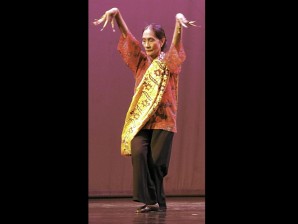In the documentary “Ang Pagbabalik sa Tawi-Tawi,” a local heroine of the arts is honored for her pioneering efforts to preserve traditional dance artistry in the province.
Ligaya Fernando-Amilbangsa, a scholar, author and choreographer, married a Muslim, Punjungan Amilbangsa, in 1964. The lass from Marikina fell in love with her spouse’s culture as well, eventually studying a dance from the region on a whim. This was the impetus for something bigger, as the docu states—her interest and research led to an active preservation of previously unrecorded dance styles, which she would later bring to Manila via a dance troupe she founded.
“Ang Pagbabalik sa Tawi-Tawi,” written and directed by Nannette Matilac, follows the return of the celebrated teacher to the province she also considered home for about four decades. The 70-year-old widow was honored with a parade, which she periodically joined—she glided with grace and dexterity that belied her age, blending effortlessly with much younger dancing participants.
Her preservation of “pangalay,” a dance consisting of meticulous hand and arm movements that mimic motions made by wind-swept flora, fauna and bodies of water, brought her to countless cultural venues through the years, according to the documentary. She made the dance—once only known to seaside communities—quite popular, and in time, her performances and teachings were passed to succeeding generations.
Sleek and informative, “Ang Pagbabalik sa Tawi-Tawi” is a 71-minute film that was screened as part of Cinemalaya’s Pinoy Pride documentaries in August. It offers a stark comparison to the present-day interpretation of the dance, as observed by Ligaya.
Subtitled in English, the documentary produced by DocuCinema Media Collective and AlunAlun Dance Circle recounts the teacher-choreographer’s early days of research, her formation of a groundbreaking dance troupe and well-deserved triumphs. It also shows Ligaya’s reunions with former students and dance members, who recall humorous or meaningful moments about learning under her.
Aptly showcasing the sprightly personality and talent of the subject through footage from her return to Tawi-Tawi, as well as taped performances from the ’70s and subsequent decades, the docu underscores the significance of Ligaya’s contributions.
“Why should we dance?” she asked during a gathering. “Because dance is living history—to disregard dance tradition is to lose history,” she emphatically told the audience.
Ligaya revealed that her efforts in dance preservation became a purpose that she devoted herself to, leading to discoveries about herself and the people she interacted with.
“[Pangalay] is just the beginning of my deeper research into Sulu culture … life there was not easy, coming from [Luzon],” she said. “[But] we don’t need so many things to keep alive. The most important things are people’s values.”
For more information on pangalay, visit pangalaydance.com.
